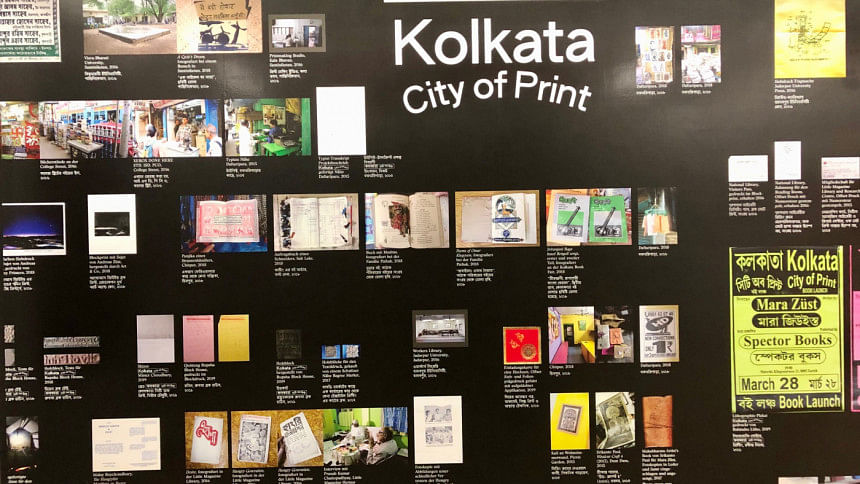Chobi Mela’s ‘Chapakhana Archive’ explores print revolution in Dhaka

In its array of collaborative initiatives, "Chobi Mela Shunno" introduced 'Chapakhana Archive', a research project. On the fourth floor of the DrikPath Bhobon, an excerpt of a nine-month project, exploring documents and local histories of print in Dhaka and its production technologies, is on display. The framework of the exhibition comes from Mara Züst's research for her project, 'Kolkata — City of Print', in association with Pathshala.
The participants from Bangladesh, Sadia Marium, Taufiqur Rahman Anik, and coordinator of the research project, Samsul Alam Helal, shared their insights with The Daily Star.
Mara Züst is an artist, a mediator, an author, and a researcher based in Zurich. Her project, 'Kolkata — City of Print', is a literary essay realised through research conducted during several stays in Kolkata, and focused on different aspects of the print medium in the city. In cooperation with her project, Chapakhana Archive explores the ideas about the deployment, function, impact, and historical indications of local engagement and characterisation of print revolution in Dhaka.

"We began the project through Chobi Mela. The exhibition has been designed with the works of Mara Züst, Sadia and Anik. After the exhibition, we shall have regular online discussions and update the research. Mara will visit Dhaka in November, that is when we might have a final output of the project," Helal shared.
'Chapakhana Archive' explores different aspects of print theoretically and in practice, from artistic printmaking to lithographed circus posters in mass circulation and self-published 'Little Magazines'. It focuses on local print-makers, publishers, entrepreneurs, and other individuals with the aim of exploring material, practical, and technological involvement of individuals and social groups, among many other facets of engagement.
Alternative printing concepts have been a central part of Sadia Marium's work. In this project, she looked for printing methods that were inexpensive and attracting a mass audience. "During the workshop, we initially discussed our interest in bookmaking that included printing concepts, book binding and more. Mara wanted us to focus in our interest zones, so we essentially explored the possibilities," she shared.
Biri packs (local cigarettes), insecticides, tooth powders and other products that are usually sold by street vendors are included in her work. In search of these everyday products, she dwelled around Dhaka in areas like Naya Bazaar, Bangla Bazaar, Paltan, Fakirapool. "When printing methods are cheap, there are interesting experimentations with size. I have always been attracted to the aesthetics of the masses," Sadia explained.
During her exploration, she found a factory that prints biri packs in Naya Bazaar. The man who claims to be the pioneer of bringing paper biri to the market also provided information about similar factories in other cities. Across this factory, she also found another space that uses cutting techniques for printing. In a nutshell, the project explores inexpensive printing techniques and inquires about its mass appeal and sustainability till date.
On the contrary, Taufiqur Rahman Anik looked into the legacy and transformation of printing methods throughout history. He believes that although new technologies may have taken over the old processes, the sight of an old compositor can make people nostalgic. Anik grew a keen interest in bookmaking since he was a third-year student in Pathshala.
"Although we have come a long way with modern printing techniques, I was looking into old letterpress concepts, their existence, their transformation, their whereabouts and if people still work with them," Anik explained. Pulling a trajectory of old methods used in the 70s and 80s, focusing on the shift from letterpress to offset printing with plates and digital method, he travelled through different areas of Dhaka in search of links. During his research, he found two old letterpress machines that were transformed into die-cut printing machines.
"Through a link from Sadia while searching areas in Joginagar, I learned that letterpress machines are still in use in our country. Dhaka University press, Bangla Academy and Chittagong Railway still use letterpress machines," he mentioned. The reason for the prolonged use, according to his research, is to prevent loss of manpower. "If they change the system, a number of workers will lose their jobs. Since they can still afford it, they are running it," he added.
Both the participants also looked into the different Bangla font styles used throughout history and its shift in the digital medium. Adding to their points Helal mentioned the opportunities of working in this project. "This can take different shapes. It can be a personal project; it can have an artistic intervention, or an academic research concept."
The researchers have enjoyed the journey of exploration so far and do not think research of this kind particularly needs any institutional intervention. They agreed that some methods will inevitably lose their purpose and become obsolete, but the possibility of transformation is also noteworthy. As far as documentation of history is concerned, they think that any work can act as a document and does not require a strict format. They mentioned that personal experiences and anecdotes are the soul of this research project.

 For all latest news, follow The Daily Star's Google News channel.
For all latest news, follow The Daily Star's Google News channel. 



Comments